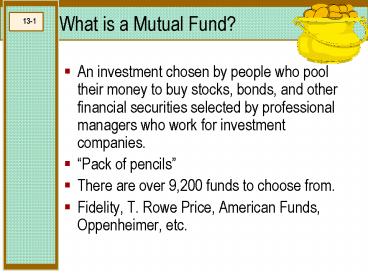What is a Mutual Fund
1 / 11
Title:
What is a Mutual Fund
Description:
13-1. What is a Mutual Fund? An investment ... There are over 9,200 funds to choose from. ... Annual fee to defray advertising and marketing costs of the fund. ... – PowerPoint PPT presentation
Number of Views:24
Avg rating:3.0/5.0
Title: What is a Mutual Fund
1
What is a Mutual Fund?
- An investment chosen by people who pool their
money to buy stocks, bonds, and other financial
securities selected by professional managers who
work for investment companies. - Pack of pencils
- There are over 9,200 funds to choose from.
- Fidelity, T. Rowe Price, American Funds,
Oppenheimer, etc.
2
Why Investors Purchase Mutual Funds
- Professional management.
- Who is the funds manager?
- How has the fund performed under the current
managers? - Diversification.
- Investors funds are used to purchase a variety
of investments. This variety provides often
provides an element of safety.
3
Load Funds compared to No-Load Funds
- Load Fund.
- Investors pay a commission (sales charge) up to
8.5 every time they purchase shares. This is
sometimes called an A fund. - Average charge is 3-5 for which an investor can
get purchase advice and explanations. - No-Load Fund.
- Investors pay no sales charge up front.
- You deal directly with the investment company
via 800 numbers or web sites, or from discount
brokers.
4
Management Fees and Other Charges
- Management fee.
- Charged yearly (.25-1.5 average) based on a
percentage of the funds asset value. - 12b-1 fees.
- Annual fee to defray advertising and marketing
costs of the fund. - Cannot exceed 1 of a funds assets per year.
- Expense ratio
- The total expenses associated with the management
fees and operating costs of the fund
5
Objective 2 Classify mutual funds by investment
objectives
- Classification of Mutual Funds
- STOCK FUNDS
- Aggressive growth funds buy stocks in small,
fast-growing companies. - Equity income funds invest in stock of companies
with a long history of paying dividends. - Global stock funds buy stock in companies in the
U.S. and other countries. - Growth funds buy stock in companies with higher-
than-average revenue and earnings growth. - Index funds buys stocks that mirror an index.
6
Classification of Mutual Funds
- International funds buy stock only in companies
outside the United States. - Large cap funds buy stock in companies with total
capitalization of at least 5 billion or more. - Lifecycle funds these funds start as being
risky and become more conservative. - Midcap funds invest in companies
with a capitalization of
1 to 5 billion.
7
Sources of Fund Information
- INTERNET
- Use websites to find current values, research a
fund. - www.morningstar.com
- www.smartmoney.com
- Check mutual fund companies Internet sites.
- www.troweprice.com
- www.vanguard.com
8
Mutual Fund Prospectus
- Mutual fund prospectus tells the funds objective,
plus - A statement describing the risk factors.
- A description of the funds past performance.
- A statement describing the type of investments in
the funds portfolio. - Information about dividends, distributions and
taxes. - Information about the funds management.
- Information about limitations or requirements for
the fund. - The process for investors to buy or sell shares.
- Services provided to investors.
- The turnover ratio of the funds investments.
9
Other Sources of Fund Information
- Mutual fund annual report.
- Performance, investments, assets and liabilities.
- Financial Publications.
- Business Week, Forbes, Kiplinger's Personal
Finance and Money are sources of information. - Business Weeks mutual fund survey includes
information such as the... - Funds overall rating compared to all other
funds, and to funds in the same category. - Fund size, sales charge and expense ratio.
- Historical returns for the past ten years.
10
The Mechanics of Mutual Fund Transactions
- RETURN ON INVESTMENTS
- There are 3 ways to make money on different funds
- Income Dividends
- Earnings a fund pays to the shareholders from its
dividend and interest income - Capital Gains Distribution
- Capital gain distributions are made to
shareholders when the fund buys and sells
securities in the fund. - Capital Gains
- You have capital gains when you sell shares at a
higher price than you paid.
11
The Mechanics of Mutual Fund Transactions
- Three ways to purchase mutual fund shares
- Your money
- Dividends
- Capital Gains































